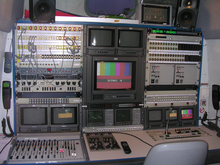Electronic reporting
As electronic reporting (abbreviated EB ; often English electronic news-gathering , ENG or electronic field production , EFP ), the recording of current events in image and sound with an electronic camera , respectively. Different video formats are used for recording . The most common format used in professional production has been Digital Betacam , but most of it is recorded in HD formats . The smallest unit for electronic reporting is a single reporter with a camcorder (so-called video journalist ), for larger tasks an EB team is used, i. d. Usually with light case / light kit, consisting of small, transportable units (e.g. IANIRO, LOCATIONSTAR, ARRI).
history
The term originated in the early 1980s with the switch from film to video technology in current reporting. With this electronic process, the recorded material no longer had to be developed and copied, as was necessary with the previous film recordings, but the video tapes ( MAZ ) could be viewed, cut, edited and sent promptly to the event. Today the term has lost its distinctive meaning, but is still in use.
Satellite reporting
Of satellite coverage (Engl. Satellite News Gathering , SNG ) is when the reports on the spot will be transmitted via a satellite to the broadcasting center.
The vehicles that contain the necessary production and transmission technology are also referred to as SNGs. Usually, fast transporters are used which, in addition to the transmission system, also have an editing suite and / or a camera. This means that smaller productions can be implemented independently without a connected broadcast vehicle (OB van).
Today in Europe almost exclusively D-SNGs are used, which transmit video and audio data digitally in the MPEG2 standard. Data rates of around 6 to 10 Mbit / s are common for news feeds; higher data rates of 16 to 24 Mbit / s are also used for high-quality productions such as sports or music broadcasts. The MPEG data stream is modulated according to the DVB-S standard with QPSK . In larger productions, SNG vehicles are often used purely as an uplink. The broadcast itself is then produced in the OB van and is fed directly to the SNG encoder via video and audio cables without loss.
The transmission system of a D-SNG usually consists of the following components: MPEG - encoder → modulator → upconverter → HPA → satellite dish
See also
literature
- Jonathan Higgins: Satellite Newsgathering. Focal Press, 2007, ISBN 0-240-51973-6




